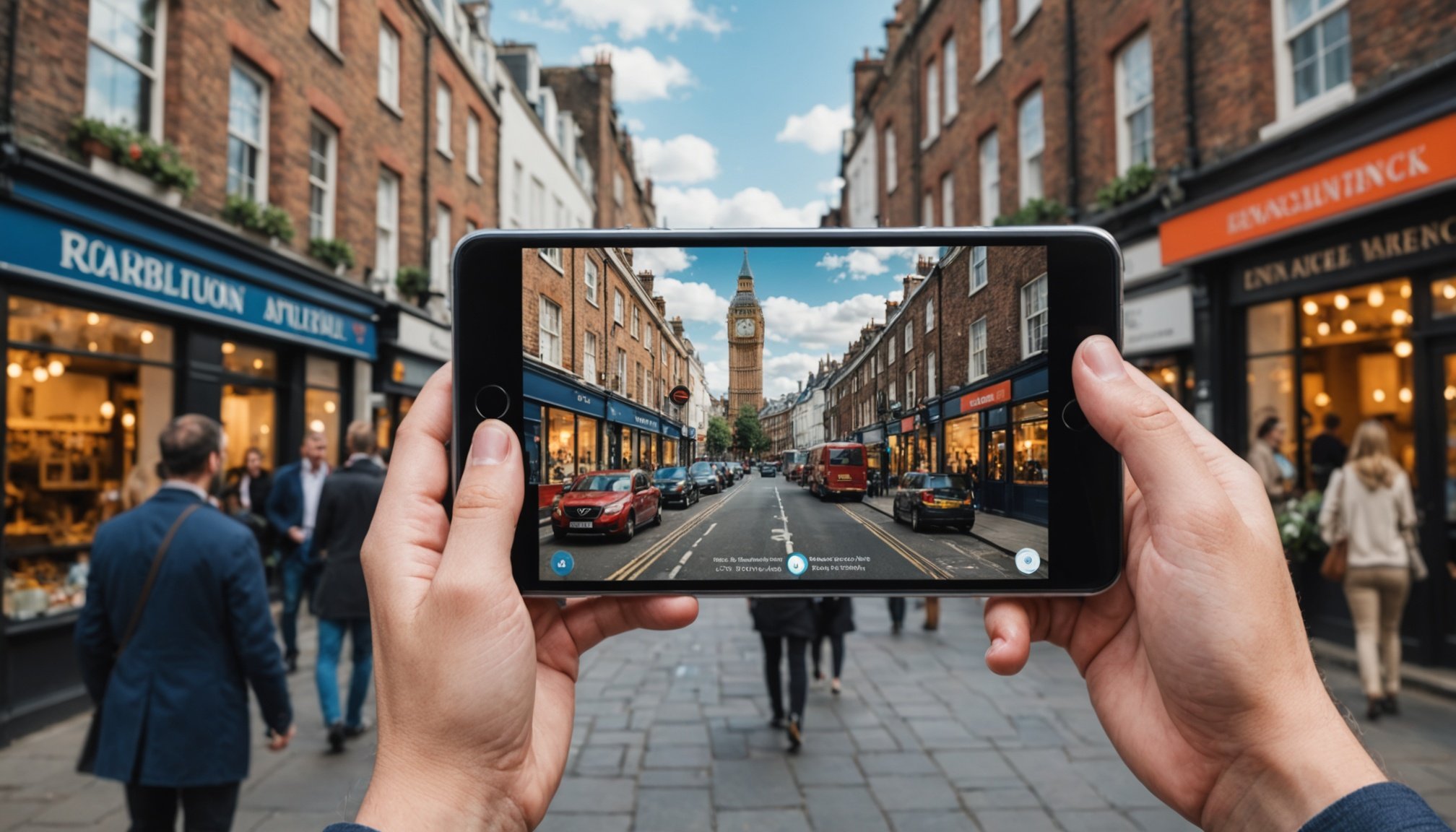Overview of Augmented Reality in Travel
Augmented Reality, a blend of the real and digital worlds, is transforming travel technology with pioneering ideas and approaches. At its core, it overlays computer-generated content onto the real world, enhancing the user’s visual and sensory experiences. It enables travellers to interact with environments augmented by virtual elements, enriching their travel experiences.
Incorporating Augmented Reality in travel technology constitutes a major innovation in travel. Current trends highlight its integration into various travel-related applications. For example, interactive navigation aids that provide augmented turn-by-turn routes or immersive historical tours that bring the past to life using a smartphone’s camera. Beyond tools, augmented reality helps in promoting destinations, where potential visitors can take virtual tours before purchasing a trip, sparking their interest through vivid previews.
Topic to read : Unlocking success: innovative data-driven marketing tactics for the fashion industry in the uk
The importance of AR as a tool for enhancing user experiences cannot be overstated. It offers a fresh way to engage with destinations—transforming the mundane into extraordinary. Augmented Reality alters how travellers plan their journeys, interact with cultural sites, and even share their experiences. Whether it’s virtually trying on clothes in a boutique or translating foreign languages on restaurant menus, AR enhances convenience and enjoyment, marking it as a significant driver of future trends in the travel industry.
Applications of Augmented Reality for UK Travel Agencies
Augmented Reality (AR) is revolutionising the way travel agencies in the UK market operate. Let’s delve into some of its exciting applications.
Topic to read : Ultimate playbook for a winning crowdfunding campaign for your uk startup
Interactive Itineraries
AR is a game-changer for crafting immersive journey plans. With this technology, users can embark on virtual tours of their desired destinations from the comfort of their homes. Imagine exploring the bustling streets of London or the serene Scottish Highlands in real-time on your device. Moreover, AR allows for a more dynamic personalisation of travel itineraries by offering tailored recommendations based on user preferences.
AR Navigation Tools
Navigating new cities can be daunting, but AR navigation tools simplify this process. These tools not only offer improved wayfinding by projecting directions onto real-world environments but also provide real-time translation and cultural insights. For example, a tourist exploring Edinburgh might receive instant information and historical context about nearby landmarks directly through an AR application.
Promotional Campaigns Using AR
AR is also revolutionising marketing for UK travel agencies. Creative AR marketing strategies captivate audiences, as seen in campaigns where users interact with virtual elements in real-world settings. For instance, a travel agency might use AR to animate iconic UK landmarks, enhancing customer interest and loyalty. Such engaging AR experiences foster stronger connections between clients and brands, boosting engagement significantly.
Benefits of Using Augmented Reality in Travel Itineraries
Augmented Reality (AR) offers a unique opportunity to revolutionise the travel experience by providing an enhanced engagement level for users. Interactive content, such as 3D tours or immersive maps, can significantly boost customer satisfaction. This engaging technology allows travellers to virtually explore destinations before their actual visit, enabling a well-informed decision-making process.
By integrating AR into trip planning, other benefits emerge in the form of increased efficiency. Travellers can seamlessly overlay their itinerary details onto a visual map, making it simpler to organise and prioritise activities. This efficiency is particularly crucial for extensive trips where logistics play a major role. AR ensures no time is lost, maximising the potential of every holiday or business trip.
Moreover, the technology opens avenues for upselling and cross-selling travel services. Imagine a scenario where a traveller is exploring an AR rendition of a historic landmark. Travel companies can swiftly offer additional guided tours or suggest nearby dining options via the same platform. This approach not only enhances the traveler’s experience, enhancing customer satisfaction, but also encourages them to discover more layers of their journey.
AR’s ability to blend interactive content with practical solutions marks a promising shift in how we can structure and enjoy our travel experiences.
Case Studies of UK Travel Agencies Utilizing AR
Exploring the impact of Augmented Reality (AR) in travel, we delve into two insightful case studies. These success stories highlight how visionary travel agencies leveraged technology to transform their operations.
Agency A: Transforming Travel with AR
Agency A embraced AR to redefine customer experiences. Implementing virtual reality tours, they enabled potential travelers to explore destinations from their homes. This innovative approach led to a 40% increase in bookings, highlighting AR’s potential in boosting consumer interest. Customer feedback was overwhelmingly positive, with many appreciating the immersive previews. A key takeaway is adopting user-friendly interfaces to simplify the experience, thus encouraging wider adoption.
Agency B: Innovative Marketing with AR
With a focus on marketing, Agency B showcased the power of AR-driven campaigns. Their campaigns allowed users to simulate activities such as skydiving or lounging on a beach through their mobile devices. This tangible engagement resulted in a striking 35% rise in engagement metrics. For agencies considering AR, it’s crucial to analyse user interactions and continuously enhance content based on customer engagement metrics. This case study underlines the importance of integrating AR within marketing strategies to captivate and engage audiences organically.
Challenges and Considerations When Implementing AR
Implementing Augmented Reality (AR) in the travel industry presents several challenges. The technical barriers include ensuring compatibility with various devices, requiring advanced hardware and software. Many companies face difficulties in investing resources needed for developing and maintaining AR applications. This complexity involves multiple layers of technology, including 3D modeling and real-time data processing, demanding a high level of technical expertise and financial commitments.
Addressing user adoption and technology literacy is another hurdle. While AR can enhance travel experiences, many users may struggle with its adoption due to limited literacy with this technology. It’s crucial to provide intuitive interfaces and comprehensive user guides to bridge this gap. Encouraging workshops and training sessions can also support users to become proficient, making the transition smoother.
Legal and ethical considerations are equally important. AR vendors need to navigate privacy concerns and ensure compliance with data protection regulations. Transparency in how customer data is used and shared is essential to gaining trust. Additionally, businesses should assess potential ethical impacts, such as the inclusivity of AR applications and the respect of cultural sensitivities, to prevent alienating users and ensure responsible use of technology.
Actionable Tips for Integrating AR into Travel Services
Implementing augmented reality (AR) within travel services requires consideration and strategic planning. Understanding tips for AR integration is crucial for success.
For starters, focus on identifying suitable AR technologies that match your agency’s specific needs. Evaluate options by assessing the technologies’ compatibility with your travel services and their potential to improve user experience. The right choice will enhance engagement and information dissemination to clients.
Secondly, devise strategies for training staff in using AR tools. This involves creating detailed training programs that ensure all employees are well-versed in the functions and benefits of AR. Well-trained staff can elevate the customer experiences with AR, making travel planning more interactive and efficient.
Implementing best practices involves continuous evaluation and adaptation. Technologies and consumer expectations are constantly evolving, making ongoing assessment critical. Regularly review feedback, update AR tools, and adapt to technological advancements to keep your travel services competitive and innovative.
Enhancing customer satisfaction with AR is not a one-time effort but a sustained process. The goal is to create a seamless integration that benefits both the agency and its clients by offering memorable and informative experiences. Embrace change positively to fully unlock the potential of AR in travel.
Visual Examples and Demonstrations of AR in Action
Augmented Reality (AR) is rapidly transforming the travel industry by offering innovative ways to explore destinations. From real-time translation apps for seamless communication to virtual tours of historic sites, AR is reshaping how we experience travel.
Showcase of AR Tools and Platforms
Several AR applications have gained traction, standing out for their innovative use in travel. Popular options like Google Maps AR and Plane Finder enhance the travel experience by overlaying visual guides and flight paths directly onto the real world. These tools provide immediate, immersive experiences, helping users navigate unfamiliar environments with ease.
In the UK, leading travel agencies are integrating AR into their services. TUI, for instance, employs AR to offer virtual hotel tours, allowing potential travellers to explore accommodations before booking. Such visual demonstrations cater to modern travellers’ needs for clarity and transparency during travel planning.
Customer Testimonials and Visual Feedback
The impact of AR is echoed in enthusiastic customer testimonials. Many express increased satisfaction, attributing comfort and convenience to AR integrations. Visual storytelling has proven critical in engaging users, highlighting the importance of feedback loops. Metrics reveal a significant uptick in user satisfaction post-AR implementation, with travellers feeling more informed and empowered. These insights underscore the transformational potential of AR in revolutionising travel experiences.











